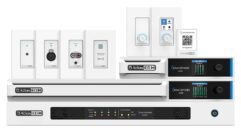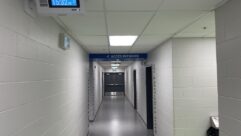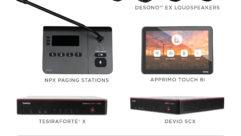
Technology Showcase: Paging Systems
Nov 1, 2004 12:00 PM,
By Mel Lambert
Manufacturers offer a wide range of options, from turnkey installation systems and component modules to centralized or decentralized solutions.
In virtually every environment, messages need to be delivered to disseminate information, locate staff, and handle emergencies quickly and securely. Paging systems enable live or pre-recorded voice announcements to be created, organized, and delivered within targeted public or private areas using existing or specially installed loudspeakers, either ceiling-mounted or a free-standing wall/column cabinets. In other words, such system might be a dedicated, standalone turnkey system or utilize an existing background/foreground music system, but would be capable of being fed messages to specific zones or all areas.
Atlas Sound Varizone
Every business needs a system that instantly notifies personnel of an emergency situation; therefore a paging system should also offer the ability to adapt the communication paradigm to carry immediate response directives. After all, during any emergency situation, people need to be able to receive clear directions that guide them to a safe location. During a routine day, workers need to receive either targeted or general interest messages about prevailing circumstances, or to respond to an incoming telephone call, for example. And within virtually every public space, announcements need to be made to direct individuals from one location to another, or to call attention to a time-sensitive event.
A number of manufacturers offer a range of paging systems that are available as a turnkey installation or as component modules that can be assembled by a contractor or added to an existing audio infrastructure. Designs basically fit into one of two major topologies: centralized and decentralized. The former involves preparing messages and announcements at a master location, and distributing the resultant audio signals via dedicated cabling to the targeted loudspeakers and ancillary devices. Modular, decentralized systems offer more flexibility since the system can be extended or otherwise modified — additional paging stations added as the environment expands, for example — by simply adding networkable components. In addition, a number of available systems integrate with an existing PBX or private-line telephone system, enabling messages and other announcements to be distributed via in-place cabling and trucking.
With recent developments in networking, a growing number of paging systems are based on Cat-5 cabling linking individually addressable IP nodes where signals can be injected, routed, or output to network-addressable amplifier modules. Traditional and VoIP (voice over IP) topologies have developed in leaps and bounds since the earlier days of 70V systems. And newer-generation wireless systems offer rapid, on-site paging functions that can support an existing overhead system.
The first of these I will look at, Atlas Sound’s Varizone, is a modular, decentralized, audio networked-matrix paging system that offers point-to-point routing, allowing any source to be sent to any speaker destination. Control is PC-based, allowing remote access, adjustment, and monitoring over WAN/LAN or via the Internet. Audio zones can be created electronically, independent of physical connections, and rezoned at the touch of a button.
The system uses the German-developed Klotz VADIS frame to route audio. Analog and digital I/O, DSP, and DSS bus output cards are loaded into the frame. Each DSS bus transmits eight channels of unidirectional digital audio, bi-directional component supervision/control data, and DC voltage via standard Cat-5.
Multiple programmable amplifier modules (PAMs) are used in conjunction with the DSS bus. A PAM is an addressable, two-channel, 25W, Class D digital in-ceiling amplifier. Each PAM typically powers four loudspeakers (two per channel) while providing voice-coil supervision to each transducer. The system controller determines which of the eight digital audio channels on a DSS bus is routed to a particular PAM channel. Level adjustment and parametric EQ also are included per PAM channel.
Five PAMs can be used with up to 660ft. of Cat-5 before data and voltage must be refreshed via a Power Bridge, which interfaces to 110VAC to provide power to the next cluster.
Australian Monitor products, manufactured by Audio Telex Communications and available in the United States through Sennheiser, include the DigiPage Zone Paging System, which is expandable from eight to 16 zones. The base station features a dedicated local mic/line input for the eight zones, plus routing between mic/line inputs to any of the 8/16 zones. Four Cat-5 ports are used to connect to remote zone paging mics and daisy-chained remote source/volume selectors.
Wall panels allow users to select among six program inputs and adjust zone volume. The DigiPage microphone station is available in 8/16 zone versions and allows paging into any zone, combination of zones, or all zones at the touch of a button.
The company’s DigiPage Junior features four program inputs and eight output zones, expandable to 16 zones via a second unit. Paging stations are available in 8/16-zone versions for paging into any individual zone or combination. One station can have priority over all others if desired. Interconnect is via Cat-5 cable. An overall priority input is also provided for emergency or evacuation signals.
Australian Monitor’s ZoneMix3 is a mixer/signal router that allows remote selection of four stereo sources from three remote stereo zones. One stereo source can have selectable priority per zone; each stereo zone boasts five-stage EQ. The unit can also route two independent mic/line signals to any single or combination of zones.
Avaya overhead paging and customer-owned systems incorporate traditional telephone access loudspeaker messages, tone signaling, and background music capabilities. The pager system incorporates voice prompts; a familiar alphanumeric format makes training easy. Suitable audio amplifiers, loudspeakers, controllers, digital message equipment, gateways, and door phones also are available.
The PCM zone equipment handles paging to a maximum of 99 zones in 32 group zones, and it includes emergency override, time tone signaling, emergency tone signaling, and talkback. Avaya’s Universal Paging Access Module acts as an interface between the paging and telephone systems.
The Multiple Digital Message Unit allows pre-recorded, digitally stored messages to be played on demand, while the Call Stacker — designed for use in busy paging environments — stores pages and plays them through the paging system once an existing page is completed. The Ambient Level Controller senses noise in an area and raises or lowers paging system volume as necessary. The Feedback Eliminator stores pages and plays them back once the caller has hung up the handset.
Avaya’s VoIP gateways for overhead paging use existing Ethernet access and allow businesses to establish simultaneous company-wide overhead paging to multiple locations on a network. The APS Series automated wireless paging system can be used to send an immediate numeric or pre-programmed alphanumeric message to any pager or groups of pagers within a facility.
Bogen’s PCM2000 zone paging controller consist of four types of modules: telephone interface, central processor, three-zone module, and talkback. Being modular, the system can accommodate between three and 99 zones (in three-zone increments). Features include up to 32 programmable paging zone groups; emergency all-zone override paging input; 250W capacity; direct night ring tone to specific zones; and zone-selectable, two-way, hands-free talkback. Background music is not interrupted in zones not being paged. Also, background music can be inhibited in any zone.
Bogen also offers its Ambient Noise Sensor System, designed to monitor continuously changing ambient noise levels and automatically adjust page announcement level or background music so intelligibility is maintained.
Its Power Vector V-Series includes bays that accept up to eight input modules and allow up to four levels of priority. Five models offer maximum power of between 35W and 250W into high- (70V/25V) and low-impedance (4Ω/8Ω) speaker loads. Wall-mount Power Vector Amplifiers (WV-Series) are available with the same features.
Bogen also offers a wide selection of speakers for both indoor and outdoor applications for general announcements, as well as background or foreground music. Choices include cabinet, ceiling (surface-mount, flush-mount, and drop-in styles), wall baffles, and landscape speakers.
Bogen’s Model TPU15A is a wall-mounting amplifier designed specifically for telephone paging. The compact unit provides voice-activated muting of music when paging, eliminating the need for manual activation of switches and external relays.
Dbx offers its professional ZonePro 1260 and 1261, which have applications as paging and background music systems, with flexible routing, DSP processing, and multiple control surfaces. The units provide 12 inputs and six outputs. Control is via RS232 serial port and/or Ethernet; zone control is via RJ-45 jacks. (Models 640 and 641 feature six inputs and four outputs.)
Models 1260 and 1261 provide zone mixing as well as signal processing. Designed to offer system flexibility and reliability, the 1260 and 1261 include a number of audio processing tools, ranging from gating and feedback suppression for paging microphones, to source ducking and priority override, and output processing (EQ, dynamics, and delay). A range of wall-panel zone controllers for source select and volume change are also available. Control software provides an interface for configuring and controlling all system parameters.
Dukane’s paging systems include the StarCall communication platform, which offers centralized and decentralized topologies. Using technologies from traditional paging and intercom, with telephony, access controls, and Windows-based application protocols, StarCall’s infrastructure is said to not rely on proprietary devices.
StarCall Plus and Fusion allow PC users to access and monitor communications and system events. Connectivity with in-house PBX and VoIP is offered, as well as the ability to function as an integrated PBX without need for a third-party switch. Paging can be broadcast locally, or through multiple StarCall systems connected via T1 for campus or district-wide messages.
In addition to offering multiple communication paths (paging/intercom and telephone) to a location for safety and security, supervision can be added to the StarCall line or provided independently. All audio and signaling lines can be supervised, including verification of speaker operation.
Other Dukane paging systems include the Compact 3200, a central switch bank paging and intercom system for up to 150 discrete locations, and the MCS350, which provides paging and intercom for up to 256 discrete locations and PBX connectivity.
Dukane also offers a range of power amplifiers, ceiling and wall loudspeakers, paging horns, and sound masking products.
Designed for integrated audio distribution and zone paging, Intelix’s MZP combines a VCA matrix mixer, setup and control software, plus programmable Comet remotes. Automatic program ducking and ramping are provided during pages. Because Intelix matrix products mix levels at each crosspoint, rather than switching crosspoints on or off, the MZP automatically ducks program material during a page, then ramps back to original level.
The function of each Comet series remote is assigned via Windows-compatible MZP Designer software; these may be altered should use of the remote change. Internet connectivity also allows the system to be monitored and controlled from virtually anywhere. Setup parameters include crosspoint levels, duck amounts, output zone groupings, and user control assignments. Wall plates in various colors and options are available. Controls include mixing to every destination, line (optional mic) level, program selection, and volume.
Up to 128 remotes can be linked together in various paging and program select stations. Typically wall- or rack-mounted, programmable modules interconnect via a LAN topology to the matrix via a single Cat-5 cable. Four remote modules are available: Comet Tail, which controls volume and muting of pages or background music; Comet 4, which offers four background music or page routing selections; Comet0-I/O, a bare version of Comet 4; and PSM, which is a custom paging station microphone.
JBL’s Soundzone music controllers feature page assignment among zones using dry contact closures. The Z32S controller features two output zones; multiple controllers can be interlinked for up to eight zones. In addition to a paging mic input that automatically reduces music level, an all-call input — an emergency message repeater, for example — lets that source be sent automatically to all zones. Mute attenuates all inputs for emergency pages.
These controllers feature LevelGuard compression to handle excessive level changes, plus AutoWarmth automatic dynamic EQ. Output zones are stereo-capable and include a built-in subwoofer crossover.
The Harman Pro companies offer a wide range of power amplifiers and in-ceiling, on-wall, and in-wall loudspeakers, including the JBL Control Contractor series and Crown XLS, CL/CH, and CTs series amps.
Telex/EV’s Dynacord ProAnnounce is designed to work with all EV speakers, mics, and amplifiers. The DPM4000 central paging processor handles up to 16 paging stations and 100 output lines. Configuration is via the Windows-compatible ProAnnounce Designer software. The DRM4000 8×2 matrix router is a paging controller that can be interfaced to the DPM4000 or function as a standalone CPU. The router features integrated page ducking, priority control, and remote volume control. DPC series paging consoles control internal functions and data communication.
The DPM4000 4×4 system controller features a digital mixing matrix with level controls in all inputs and outputs, plus parametric EQ. Additional matrix junctions provide integrated chime and alarm signal generators, vocal recording/playback unit, and pilot tone lock-on. DCS 400 series expansion components increase control functions.
The DPA4120/40 amplifiers have been designed to ensure reliable operation of paging systems with several independent loudspeaker lines. The amps can be operated either on the AC mains or connected to an external 24V battery. The DPA4411 provides 4×100W and offers simultaneous operation of 70V and 4Ω speakers.

JBL Soundzone
The ProAnnounce DTI2000 telephone interface features 100 available zones and up to 20 calling groups. Selection of multiple zones or groups is also provided, along with pre-recorded message triggering.
TOA Electronics’ products include microphones, mixers, amplifiers, speakers, processors, and the NX-100 network audio adapter. This adapter distributes audio over IP networks — LANs, WANs, and the Internet — for wide-area paging applications.
TOA’s BG-M series of five-channel mixer/amplifiers includes four models, from the 15W BG-1015 to the 120W BG-1120. Inputs include two dedicated inputs for paging; a mic input is active balanced, and a telephone input transformer-balanced. A switch-selectable, normally-off paging mode allows paging inputs to be activated by contact closure, including multiple-zone paging using one mixer amp per zone. Two inputs are provided for background music. Auto-mute dims the music when paging.
TOA’s 700 series nine-channel mixer/amplifiers offer functions for auditoriums that require several microphones plus override, or restaurants featuring several music and program sources plus paging mics. Inputs include six switchable mic/line and two auxiliary ports, plus a slot that accepts a TOA 900 series plug-in module. Channel 1 features transformer isolation for use with a telephone system’s paging output.
Valcom offers a range of page control interfaces, VoIP LAN/WAN connectivity, and ceiling/wall speakers interconnected with standard telephone/datacom wiring (Cat-3/5/5e/6). Distributed paging speakers feature built-in amplifiers and volume controls, and function essentially as independent PA systems that can be networked.
A new distributed paging system based on VoIP provides 1,024 zones of paging and 256 page groups. Compatible with existing Valcom products — networked and analog — the system has four components: the VIP-200 distributed paging controller; the VIP-402 2×2 lay-in IP ceiling speaker; the VIP-410 wall baffle IP speaker; and the VIP-908 power over Ethernet (PoE) switch. (The VIP-402 and VIP-410 IP use PoE.)
Valcom’s VIP-200 allows integration with SIP-based telephone systems and provides scheduled playback of pre-recorded messages/tones and a text-to-speech capability. Users can initiate pre-programmed messages via an Internet-based interface. The controller provides mapping of SIP phone numbers to paging zones and groups, allowing dial access for realtime paging.
The VIP-908 eight-port 10/100 802.3af switch features PoE for battery backup for an entire paging system by centralizing all power needs to the equipment room.
Valcom’s MultiPath systems combine the features of an electronic telephone system with the capabilities of a sound and program distribution system, including emergency call paging and alarm functions.
Zenitel USA (formerly Stento USA), a manufacturer of security and communications systems, offers a range of AlphaCom intercom message routing products, as well as multi-input mixer-amplifiers. Models are rated between 10W and 120W. All models feature auxiliary and program inputs for music plus automatic muting and controls for paging from microphones, telephones, and intercoms. All units include a 0dB, 600Ω telephone/intercom interface.
Mel Lamberthas been involved with sound contracting and live-performance industries on both sides of the Atlantic for more years than he cares to remember. Now principal of Media&Marketing, a Los Angeles-based consulting service for audio, video, and multimedia, he can be reached at[email protected]; 818-753-9510.
For More Information
Atlas Sound
www.AtlasSound.com
Audio Telex Communications Pty Ltd
www.audiotelex.com.au
Australian Monitor
www.australianmonitor.com
Avaya Inc.
www.avaya.com
Bogen Communications, Inc.
www.bogen.com
dbx Professional Products
www.dbxpro.com
Dukane Communication Systems
www.dukane.com/csd
Intelix
www.intelix.com
JBL Professional
www.jblpro.com/businessmusic
Telex Communications
www.telex.com
TOA Electronics, Inc.
www.toaelectronics.com
Valcom, Inc.
www.valcom.com
ZenitelUSA
www.zenitelusa.com










